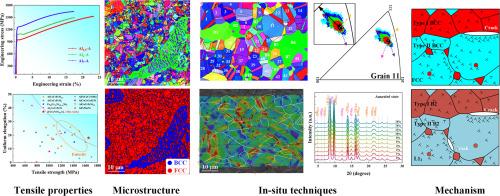原位技术研究超细晶(FeCoNiV)93Al7双相高熵合金强塑性协同作用机理
IF 14.3
1区 材料科学
Q1 MATERIALS SCIENCE, MULTIDISCIPLINARY
引用次数: 0
摘要
双相高熵合金(HEAs)具有软基体和硬增强相的特点,具有优异的力学性能,但由于增强相在提高强度的同时显著降低了延性,因此难以平衡强度和塑性。在这项研究中,我们设计了超细晶双相(FeCoNiV)93Al7 HEA中有序和非均匀结构的耦合,从而产生了强度和延展性的杰出协同作用,屈服强度为1260 MPa,极限抗拉强度为1651 MPa,延伸率为18%。利用先进的原位技术(电子背散射衍射、数字图像相关和同步加速器x射线衍射),我们系统地研究了变形机制。我们的研究结果表明,力学性能是由有序处理、晶粒尺寸、相体积分数和相形态的复杂相互作用决定的。在初始变形阶段,L12相的屈服引发应力松弛,随后应力向较硬的B2相转移,显著提高了屈服强度和加工硬化速率。值得注意的是,该合金中的L12相表现出优异的加工硬化能力,但随着应变的增加,载荷逐渐转移到最初较软但应变硬化的L12相。两相之间的动态应力重分布有效地延缓了合金失效的发生。为了优化机械性能,通过加工技术保持适度的B2相体积分数和最小化粗B2晶粒是至关重要的。这种对双相HEAs变形和断裂机制的深入理解为推进合金设计和优化策略提供了有价值的见解。本文章由计算机程序翻译,如有差异,请以英文原文为准。

The mechanism of superior strength-ductility synergy in ultrafine-grained (FeCoNiV)93Al7 dual-phase high-entropy alloy via in-situ techniques
Dual-phase high-entropy alloys (HEAs), characterized by a soft matrix and hard reinforcing phase, hold promise for exceptional mechanical properties, yet struggle to balance strength and plasticity due to the reinforcing phases enhancing strength while significantly reducing ductility. In this study, we engineered the coupling of ordered and heterogeneous structures within an ultrafine-grained dual-phase (FeCoNiV)93Al7 HEA, resulting in an outstanding synergy of strength and ductility, with a yield strength of 1260 MPa, ultimate tensile strength of 1651 MPa, and elongation of 18%. Employing advanced in-situ techniques (electron backscatter diffraction, digital image correlation, and synchrotron X-ray diffraction), we systematically investigated the deformation mechanisms. Our findings demonstrate that the mechanical properties are governed by a complex interplay of ordering treatment, grain size, phase volume fraction, and phase morphology. In the initial deformation stage, the yielding of the L12 phase triggers stress relaxation and subsequent stress transfer to the harder B2 phase, which significantly enhances yield strength and work-hardening rate. Notably, the L12 phase in this alloy exhibits exceptional work hardening capability, but as strain increased, load progressively transferred to the initially softer yet strain-hardening L12 phase. The dynamic stress redistribution between the two phases effectively retards the onset of alloy failure. To optimize mechanical performance, maintaining a moderate B2 phase volume fraction and minimizing coarse B2 grains through processing techniques is critical. This in-depth understanding of deformation and fracture mechanisms in dual-phase HEAs provides valuable insights for advancing alloy design and optimization strategies.
求助全文
通过发布文献求助,成功后即可免费获取论文全文。
去求助
来源期刊

Journal of Materials Science & Technology
工程技术-材料科学:综合
CiteScore
20.00
自引率
11.00%
发文量
995
审稿时长
13 days
期刊介绍:
Journal of Materials Science & Technology strives to promote global collaboration in the field of materials science and technology. It primarily publishes original research papers, invited review articles, letters, research notes, and summaries of scientific achievements. The journal covers a wide range of materials science and technology topics, including metallic materials, inorganic nonmetallic materials, and composite materials.
 求助内容:
求助内容: 应助结果提醒方式:
应助结果提醒方式:


